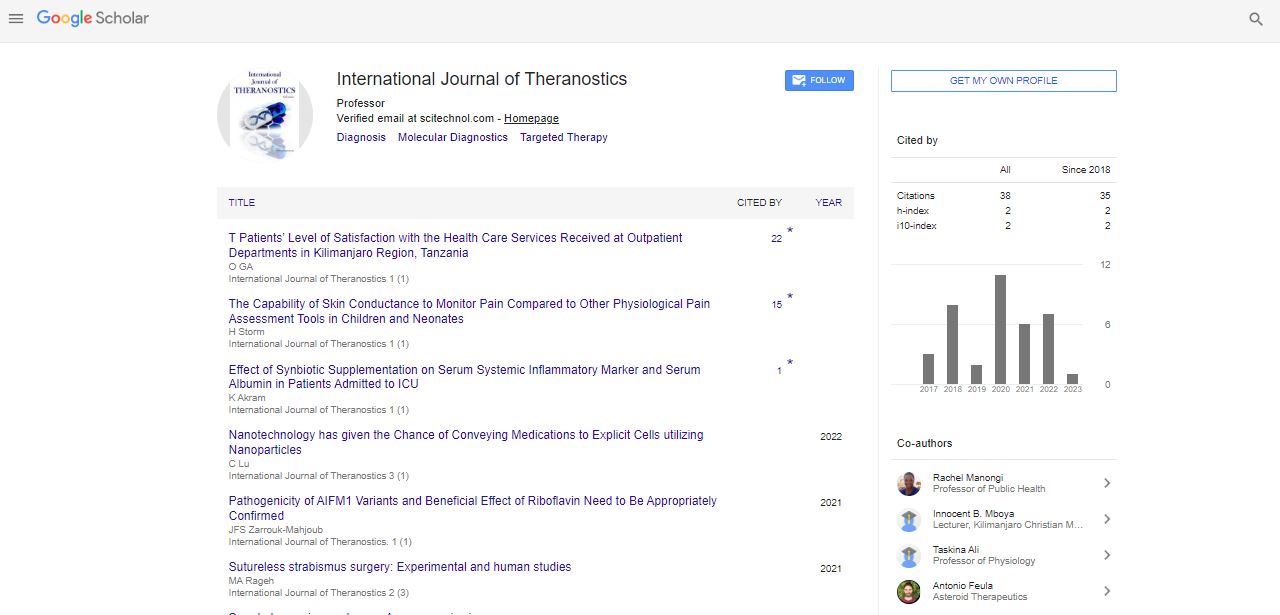Opinion Article, Int J Theranostic Vol: 12 Issue: 2
Routine Clinical Practice: Exploring Theranostics in Cardiology
Teipel Zhou*
1Department of Biomedical Nanotheranostics, University of Tokyo, Tokyo, Japan
*Corresponding Author: Teipel Zhou,
Department of Biomedical Nanotheranostics,
University of Tokyo, Tokyo, Japan
E-mail: Zhouipel65@hotmail.com
Received date: 29 May, 2023, Manuscript No. IJT-23-106938;
Editor assigned date: 31 May, 2023, PreQC No. IJT-23-106938 (PQ);
Reviewed date: 14 June, 2023, QCNo IJT-23-106938;
Revised date: 21 June, 2023, Manuscript No. IJT-23-106938 (R);
Published date: 30 June, 2023, DOI: 10.4172/IJT.1000127
Citation: Zhou T (2023) Routine Clinical Practice: Exploring Theranostics in Cardiology. Int J Theranostic 12:2.
Description
Theranostics has opened new avenues in cardiology, offering the potential to transform the diagnosis and treatment of cardiovascular diseases. This study provides a comprehensive review of theranostics in cardiology, covering its applications in early diagnosis, personalized treatment, and monitoring of cardiovascular conditions. Additionally, it discusses the challenges and opportunities in implementing theranostics in routine clinical practice.
Cardiovascular Diseases (CVDs) remain a significant global health concern. Theranostics, combining diagnostics and therapeutics, has emerged as a hopefull approach to address the complexities of CVD management.
Imaging techniques in cardiac theranostics
Molecular imaging: Molecular imaging techniques, such as Positron Emission Tomography (PET) and Single-Photon Emission Computed Tomography (SPECT), enable the visualization of specific molecular targets in the cardiovascular system. This aids in early detection and characterization of CVDs, providing valuable insights for personalized treatment.
Multimodal Imaging
Combining multiple imaging modalities, such as MRI and nuclear imaging, allows for comprehensive evaluation and precise anatomical and functional assessments of the heart and blood vessels.
Therapeutic applications in cardiology
Targeted drug delivery: Theranostic approaches in cardiology involve targeted drug delivery systems that deliver therapeutic agents precisely to the affected sites. Nanoparticles and liposomes loaded with drugs can enhance drug bioavailability and minimize off-target effects.
Gene therapy: Theranostics plays a pivotal role in gene therapy for CVDs. Molecular imaging assists in the identification of gene expression patterns, ensuring targeted delivery of therapeutic genes and tracking their effectiveness over time.
Personalized medicine in cardiology
Risk stratification: Theranostics enables risk stratification in individuals at risk of developing CVDs. Biomarkers and imaging data assist in identifying high-risk patients, allowing for early intervention and preventive measures.
Individualized treatment plans: The ability to identify specific molecular targets and disease characteristics through theranostics enables clinicians to design personalized treatment plans, optimizing therapeutic outcomes and minimizing adverse effects.
Disease monitoring and therapeutic response
Early detection of progression: Theranostic imaging facilitates the early detection of disease progression and assists in predicting potential complications, enabling timely intervention.
Monitoring therapeutic response: By tracking treatment response in real-time, theranostics helps clinicians assess the effectiveness of interventions and modify treatment strategies accordingly.
Challenges and opportunities
Translational barriers: Translating theranostics from bench to bedside in cardiology faces challenges in terms of safety, regulatory approval, and cost-effectiveness. Collaborative efforts between researchers, clinicians, and industry partners are important to overcoming these barriers.
Accessibility and affordability: The widespread adoption of theranostics in cardiology demands improved accessibility and affordability of imaging technologies and targeted therapies. Advocacy for healthcare policy changes and research investments are essential to achieve these goals.
Future Directions
The continued development of novel imaging agents, targeted therapies, and advancements in nanotechnology holds immense potential for advancing theranostics in cardiology. Further research and clinical studies will refine theranostic approaches and foster their integration into routine clinical practice.
Conclusion
Theranostics offers a hopefull approach to transform the field of cardiology, enabling early diagnosis, personalized treatment, and disease monitoring. With ongoing research and collaborative efforts, theranostics is poised to play a pivotal role in improving patient outcomes and reducing the burden of cardiovascular diseases worldwide.
 Spanish
Spanish  Chinese
Chinese  Russian
Russian  German
German  French
French  Japanese
Japanese  Portuguese
Portuguese  Hindi
Hindi 